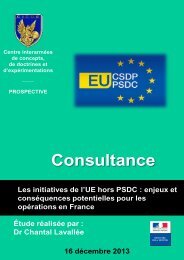Conference
science-research-bulletin-2013-conference
science-research-bulletin-2013-conference
Create successful ePaper yourself
Turn your PDF publications into a flip-book with our unique Google optimized e-Paper software.
EUROPEAN POLICE SCIENCE AND RESEARCH BULLETIN<br />
SPECIAL CONFERENCE EDITION<br />
Figure 1. Trust in the police in 16 European countries. Mean scores of the question: ‘Using this card,<br />
please tell me on a score of 0 b- 10 how much you personally trust each of institutions I read out. 0<br />
means you do not trust an institution at all, and 10 means you have complete trust’. Source: European<br />
Social Survey.<br />
placed by the respondents on certain institutions,<br />
such as the police. Figure 1 shows the results of<br />
the year 2010 for 16 countries.<br />
As we can see, trust in the police varies significantly<br />
between the different European countries. The<br />
police are clearly trusted the most in the Nordic<br />
countries and Germany, and the least in certain<br />
Eastern European countries. The indicator used<br />
has an integer scale with a range of 1–10. Since<br />
the country-specific averages of this kind of an<br />
indicator vary from less than four to eight, the<br />
differences can truly be considered great. In<br />
addition, it seems that these country-specific<br />
differences are fairly stable, if we observe the<br />
results of previous ESS-studies, for example.<br />
Naturally this presents the question of what<br />
really causes these significant country-specific<br />
differences in trust. Is the police in Northern<br />
Europe both more efficient and treating the<br />
citizens better than their colleagues in the Eastern<br />
Europe or certain countries in Southern or Central<br />
Europe? It is not possible to draw such a simplistic<br />
conclusion, for several reasons.<br />
Firstly, the empirical studies that have been<br />
conducted so far to bolster instrumental and<br />
procedural explanations have been mainly<br />
conducted in the United States and the United<br />
Kingdom (e.g. Sunshine & Tyler, 2003; Jackson<br />
& Bradford, 2009). However, there are already<br />
some published studies from Continental Europe,<br />
and the study activities in this field seem to be<br />
increasing (see e.g. Hough, Jackson & Bradford,<br />
2013; Van Damme, Pauwels & Svensson, 2013;<br />
Kääriäinen, 2008).<br />
Secondly, most of the surveys referred to above<br />
measure more the images and expectations of the<br />
respondents rather than their real and personal<br />
experiences with the activities of the police. Most<br />
of those who responded to the questionnaire<br />
surveys have no personal experiences with the<br />
92





